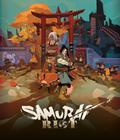Buy Samurai Riot
Beat-'em-ups are simple affairs: You walk in one direction, lay waste to anything in your path using whatever means necessary, and repeat the process until you beat the game. It's everything else that makes them memorable, whether it's the characters or a new gameplay mechanic. Samurai Riot tries to go for something new, but the limited nature of that mechanic means it has to rely on the basics to be enjoyable. Unfortunately, those basics aren't good enough to carry the game very far.
The story is fairly typical for the genre, but the surrounding details are interesting. It's set in a mashup of modern Japan with feudal tendencies, and you play the role of either Sukane, the kunoichi with a fox companion, or Tsurumaru, a loyal samurai in service to the empire. Initially, the duo is sent to quell the rebels that are trying to overthrow the ruling class. Soon, the duo is wrapped up with a demonic horde that's trying to overrun the country.
As in many other beat-'em-ups, the story is mostly a throwaway affair, but it contains several different storylines due to the game's branching path system. At the end of every level, you're given a chance to make a decision, such as turning your back against your clan leader and defecting to a new clan or sticking by your orders while watching others starve. While these choices affect nothing else but the story, you'll be able to get up to eight different endings because of it, so there's some replayability for those with a slight interest in the tale.
You start off by choosing the school where your character was trained. There are only four schools available at the start, but the gold earned from multiple playthroughs allows you to gain access to seven more schools. The choice allows for some modified stats, like increased agility, fury, health and strength, but those increases are so slight that the school choice basically serves as your character's color palette.
From here, the standard beat-'em-up procedure applies. Either alone or with a friend, you go around a level beating up a small cast of enemies who sport different color palettes before you reach a boss. Random objects, like large stones and telephone booths, are there to break open for health and gold, but there are no weapons you can pick up and use to attack enemies. If you're playing with a friend, the choices made at the end of each stage become more interesting. Agree with one another, and the game proceeds normally, but any disagreements are settled in an impromptu on-on-one fight, where the winner gets their choice honored and the loser must follow along.
There's certainly nothing wrong with just being a standard beat-'em-up, especially since the base mechanics are intuitive and work well. At the same time, there are a few things it does to decrease one's enjoyment of the title. The boss fights aren't exciting, and instead of being novel experiences, they grow dull since the same enemy appears again in the next stage, only with a lower health bar. The regular enemies are plentiful and gang up on you from all sides, but they're hard to take down either alone or in groups. They take too many hits to kill, so your heroes don't come off as being powerful since it takes a lot of effort to fell one measly foot soldier. The length of the stages is also questioned, as it can take a very long time to clear one level, especially when you take into account the health meters of every regular foe. The genre was never known for having long levels, and seeing that applied here will make you an advocate for beat-'em-ups to have much shorter stages.
From a presentation standpoint, Samurai Riot is interesting. The graphics look like they have an animated Flash style to them but without the many animation frames to make the experience smooth. The designs are fine and the colors are bold, making up for the lack of special effects for special attacks. The music, however, stands out since it mixes in Japanese instruments with more of a hip-hop flavor. The tracks are short, and you can tell exactly when it loops, but if you loved the soundtracks for shows like "Samurai Champloo" and "Afro Samurai," this will be a perfect fit for you.
Samurai Riot is a passable experience. The fighting mechanics are fine, and the moral choices add something to the game, even if the story that accompanies it is rather uninteresting. The pacing, however, detracts enough from the game that unless you want to see all of the potential storylines, you'll stop playing if you can muster enough interest to finish one storyline. If you plan on playing this with a friend, then it isn't a bad purchase, but those looking for more from their beat-'em-ups can skip this one for now.
Score: 6.5/10
More articles about Samurai Riot











 Follow the adventures of Sukane and Tsurumaru in this hand-painted 2D co-op beat-'em-up.
Follow the adventures of Sukane and Tsurumaru in this hand-painted 2D co-op beat-'em-up.


























